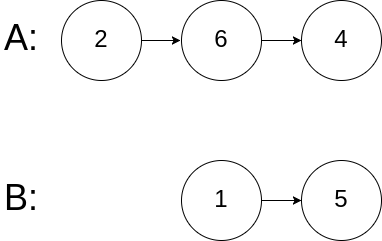1 题目
Write a program to find the node at which the intersection of two singly linked lists begins.
For example, the following two linked lists:

begin to intersect at node c1.
Example 1:

Input: intersectVal = 8, listA = [4,1,8,4,5], listB = [5,0,1,8,4,5], skipA = 2, skipB = 3
Output: Reference of the node with value = 8
Input Explanation: The intersected node's value is 8 (note that this must not be 0 if the two lists intersect). From the head of A, it reads as [4,1,8,4,5]. From the head of B, it reads as [5,0,1,8,4,5]. There are 2 nodes before the intersected node in A; There are 3 nodes before the intersected node in B.Example 2:

Input: intersectVal = 2, listA = [0,9,1,2,4], listB = [3,2,4], skipA = 3, skipB = 1
Output: Reference of the node with value = 2
Input Explanation: The intersected node's value is 2 (note that this must not be 0 if the two lists intersect). From the head of A, it reads as [0,9,1,2,4]. From the head of B, it reads as [3,2,4]. There are 3 nodes before the intersected node in A; There are 1 node before the intersected node in B.Example 3:

Input: intersectVal = 0, listA = [2,6,4], listB = [1,5], skipA = 3, skipB = 2
Output: null
Input Explanation: From the head of A, it reads as [2,6,4]. From the head of B, it reads as [1,5]. Since the two lists do not intersect, intersectVal must be 0, while skipA and skipB can be arbitrary values.
Explanation: The two lists do not intersect, so return null.Notes:
If the two linked lists have no intersection at all, return null.
The linked lists must retain their original structure after the function returns.
You may assume there are no cycles anywhere in the entire linked structure.
Your code should preferably run in O(n) time and use only O(1) memory.2 尝试解
2.1 分析
将L1所有节点存储在map中,遍历L2时,查看是否有节点在map中,如果有的话,返回该节点,否则不存在。
2.2 代码
class Solution {
public:
ListNode *getIntersectionNode(ListNode *headA, ListNode *headB) {
map<ListNode*,int> saver;
while(headA != NULL) {
saver[headA] = 1;
headA = headA->next;
}
while(headB != NULL) {
if(saver.count(headB) != 0)
return headB;
headB = headB->next;
}
return NULL;
}
};3 标准解
3.1 分析

令L1 = LA+LB,L2 = LB+LA,p1 = L1.head,p2 = L2.head。令p1,p2同时遍历L1,L2,如果有交叉节点,则会在第一个交叉节点处相遇。否则都会达到L1,L2结尾NULL。
3.2 代码
ListNode *getIntersectionNode(ListNode *headA, ListNode *headB)
{
ListNode *p1 = headA;
ListNode *p2 = headB;
if (p1 == NULL || p2 == NULL) return NULL;
while (p1 != NULL && p2 != NULL && p1 != p2) {
p1 = p1->next;
p2 = p2->next;
//
// Any time they collide or reach end together without colliding
// then return any one of the pointers.
//
if (p1 == p2) return p1;
//
// If one of them reaches the end earlier then reuse it
// by moving it to the beginning of other list.
// Once both of them go through reassigning,
// they will be equidistant from the collision point.
//
if (p1 == NULL) p1 = headB;
if (p2 == NULL) p2 = headA;
}
return p1;
}